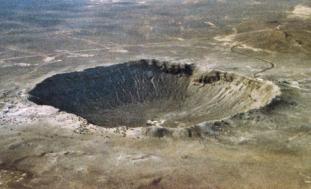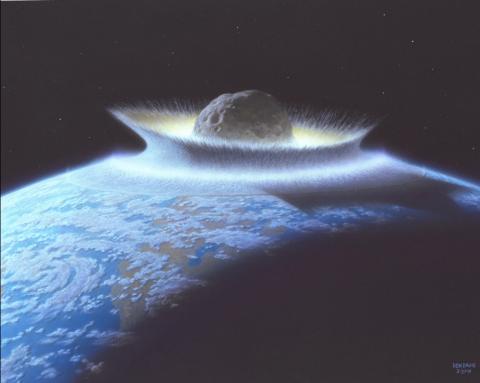Near Earth Objects (NEOs) are objects in space on orbits which come near to the Earth.
They are often comets or asteroids. Most NEOs were once part of the asteroid belt. Then gravity from the Sun or inner planets pulled them out of place. Or they collided with another asteroid, which knocked them towards the Sun.

An NEO's orbit takes it within 1.3 AU of the Sun. The largest known NEO is over 40 km in diameter, but astronomers have found thousands of NEOs with diameters larger than 1 km. Anything smaller is too hard to see.
Meteoroids are small pieces of rock from an asteroid or comet. Lots of meteoroids enter Earth's atmosphere each day. Their superfast speed through the air causes them to burn up as they fall. The glow we see from this is called a meteor (or shooting star).
Some rocks survive to hit the ground. We call these meteorites. Most are the size of a pebble by the time they reach the Earth's surface.
- Impacts
Large objects have hit the Earth many times over its 4,500 million-year history. We know this because these Near Earth Objects (NEOs) left clues in the Earth's rocks. When a large rocky object hits another, it leaves an impact crater. NEOs that make craters travel at thousands of miles per hour when they hit the ground. The Earth has more than 160 large impact craters on its surface.
Meteor Crater in Arizona, USA, was the first impact crater discovered on Earth. The NEO that made Meteor Crater (also called Barringer Crater) was just 40-50 m wide. When it crashed, its energy caused an explosion that left a huge crater in the ground. Meteor Crater is 1,200 m wide, which is as long as 11 football pitches!
Some craters are harder to find, like the Chicxulub Crater. It is off the coast of Mexico and has been covered by the sea floor. We think the same event that created the Chicxulub crater led to the extinction of the dinosaurs! The largest crater on Earth is the Vredefort crater in South Africa. It is 300 km wide and 2,000 million years old.
In 1908, a meteor or comet broke up in the air above Tunguska, Siberia. Scientists have worked out it was under 50 m in size when it exploded. This is large for a meteor but tiny for an asteroid! It made a shock wave which flattened 80 million trees! In 2013, a similar but much smaller event took place in Chelyabinsk, Russia. Remember, events like Tunguska or Chelyabinsk do not happen often.
Image CreditThis work by D. Roddy, US Geological Survey is licensed under Creative Commons Zero v1.0 Universal
CreditThis work by D. Roddy, US Geological Survey is licensed under Creative Commons Zero v1.0 UniversalMeteor Crater in Arizona - Risks and probabilities
It is possible that a large NEO could collide with the Earth in the future. The impact would cause widespread damage. The most dangerous objects are the biggest and closest ones to the Earth. A hazard does not mean it will hit the Earth.
Astronomers track NEOs in case they are a threat to Earth in the future. Scientists want to "push" any hazardous NEOs out of the way. We need to spot these hazards early to do this. By seeing them early, we can prevent a disaster.
Remember that a large asteroid colliding with the Earth is not likely! The risks from a NEO increase with its size. The bigger the NEO, the more energy it has when it hits the Earth. NEOs wider than 1 km are the biggest danger to Earth. Impacts from these large objects could damage a large area or even affect the whole world.
Large NEOs are not likely to pass close to our planet often. We know they will hit the Earth a few times each million years on average. These statistics cannot tell us what year a serious collision will occur. This is why it is important to track the orbits of NEOs. If we know the path a NEO will take, we can plan a way to prevent a collision. We could use rockets or explosives to nudge the NEO out of harm's way!
- Consequences of impacts
A large asteroid or comet will have catastrophic effects if it hits the Earth. The power of such a large impact would cause damage across a huge area. It would reach far wider than the crater left behind. Scientists think they hit the Earth a few times every million years on average.
So, what would happen if a large asteroid or comet collided with the Earth?
The first danger would be the huge shock wave caused by the impact. The shock wave would move out from the impact site at very high speeds, carrying a lot of heat with it. It could lead to scorching hurricane-force winds, strong earthquakes, and widespread fires.
The impact would throw millions of tonnes of dust into the air. Or, if the object lands in the sea, tonnes of water vapour. Scientists have used computer models to simulate large impacts and study how much dust or water vapour they create. The results show a large asteroid would produce 1000 times its volume in dust or vapour. The models show the impact sends dust or vapour straight into the upper atmosphere via a process called the "chimney effect".
We would see a change in the weather soon after the shock wave passed. All the dust and water vapour in the atmosphere would block out the Sun's light. Global temperatures would fall due to the lack of heat from the Sun. This dust could remain in the air for many months if not years.
In the worst case, plants would not have enough light to carry out photosynthesis. Photosynthesis uses sunlight, water, and carbon dioxide to create oxygen. So, the impact could change the chemical composition of the air. This is vital for life on Earth so there could be mass extinctions. Scientists think the extinction of the dinosaurs 65 million years ago was because of a large asteroid impact.
Image CreditThis work by NASA/Bern Oberbeck/Dr. Kevin Azhnle is licensed under Creative Commons Zero v1.0 Universal
CreditThis work by NASA/Bern Oberbeck/Dr. Kevin Azhnle is licensed under Creative Commons Zero v1.0 UniversalArtists's impression of NEO impact
